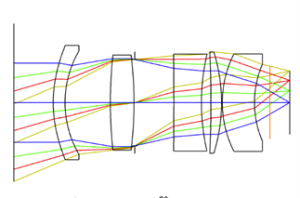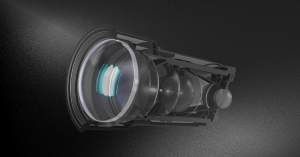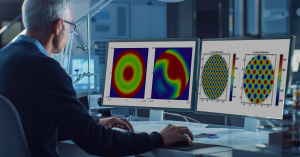Key Takeaways: Thermal management in space optics
- Thermal management in space optics ensures stable performance across the wide thermal variations typical of orbital environments—using passive techniques like matched-CTE materials, athermal optical design, and radiative shielding.
- These strategies prevent focus shift, wavefront distortion, and mechanical misalignment without adding mass or complexity.
- From CubeSats to deep space missions, athermalized optics and precision engineering are essential for reliable, high-resolution imaging in orbit.
Precision optical systems deployed in space must operate across extreme thermal conditions. Without atmospheric insulation or convective cooling, optics in satellites and space instruments rely on passive thermal management to maintain performance.
In this article, we explore how optical components behave in orbit, and how engineers ensure thermal stability using passive stabilization techniques and athermal optical design.
Optical Performance Across Extreme Temperatures
In the vacuum of space, optical systems are subject to large and rapid temperature swings. These fluctuations can lead to:
- Thermal expansion and contraction in lenses, mirrors, and housings
- Changes in refractive index due to material dn/dT properties
- Focus shift and aberration from CTE mismatch
- Mechanical misalignment from uneven expansion
These effects are particularly problematic in high-precision applications like space telescopes, hyperspectral imagers, and optical communication systems, where wavefront stability is essential.
Key Passive Thermal Management Techniques
1. Matched CTE Material Selection
To mitigate stress and deformation, optical engineers select materials with low and matched coefficients of thermal expansion (CTE). Common choices include:- Fused silica, ULE®, and Zerodur® for optical substrates
- Invar or titanium alloys for opto-mechanical mounts

2. Athermal Optical Design Principles
An athermalized optical design compensates for temperature-induced changes by:- Pairing optical materials with opposing dn/dT values
- Integrating mechanical elements that offset focus shift with temperature
- Utilizing spacers, compensator lenses, or sliding mechanisms in the design

3. Radiative Thermal Shielding
To manage heat flux from solar exposure and deep space cooling:- MLI (multi-layer insulation) is applied to optical benches and housings
- Radiative surface coatings are tuned for optimal emissivity and absorptivity
- Sunshields and baffles reduce direct thermal load on sensitive optics
4. Thermal Doublers and Heat Spreaders
To prevent thermal gradients across optics:- High-conductivity materials like pyrolytic graphite are used to equalize temperatures
- Thermal doublers spread heat from local sources such as sensors or electronics
- Isothermal designs reduce the risk of wavefront error from localized warping
5. Structural Symmetry and Isolation
Thermal performance also benefits from:- Symmetric layout of optical assemblies to balance expansion
- Mechanical isolation from heat-generating subsystems (e.g., electronics)
- Flexure mounts that accommodate expansion without inducing stress
Why Passive Thermal Control Matters in Space Optics
Passive thermal control enables:
- Lower system complexity and power consumption
- Increased mission reliability
- High-resolution imaging despite thermal stress
- Compliance with mass and volume constraints in small satellite platforms
Whether you’re working on CubeSats, large space telescopes, or interplanetary instruments, passive thermal management is essential for optical accuracy in orbit.
Partner with Experts in Thermal-Resilient Optics
At Avantier, we design and manufacture custom space optics engineered for thermal resilience. Our capabilities include:
- Precision athermal optical design
- Advanced material selection and CTE matching
- Custom opto-mechanical assemblies for LEO, GEO, and deep space platforms
- Extensive experience in wavefront control under thermal stress
If your mission requires optical performance in extreme thermal environments, contact our team for a consult on your next-generation payload.
FAQ: Thermal Management in Space Optics
1. Why not use active thermal control for all space optics?
Active systems (like heaters or cryocoolers) add mass, power consumption, and potential failure points. For many missions—especially CubeSats or long-duration probes—passive thermal control offers greater reliability and simplicity while meeting stringent size and energy constraints.
2. What materials are best for optics in space environments?
Fused silica, Zerodur®, and ULE® are commonly used for mirrors and lenses due to their ultra-low thermal expansion. For mounts, Invar, titanium, and carbon composites offer CTE compatibility and high stiffness.
3. How does athermalization compensate for thermal drift?
Athermalized optical designs balance the temperature dependencies of refractive index (dn/dT) and mechanical expansion (CTE). This ensures that as temperature changes, optical path length and focal position remain stable or self-correcting, preserving image quality.
4. Can passive techniques handle sudden thermal shocks?
They can mitigate but not fully eliminate thermal shock effects. Designing with low CTE, symmetric supports, and high-conductivity elements helps minimize distortion. However, mission profiles must be evaluated carefully, especially for instruments exposed to eclipse transitions or rapid sun exposure.
5. Are passive thermal management strategies scalable to large optics?
Yes. Many large-aperture space telescopes (e.g., JWST, Gaia) rely heavily on passive strategies. These include deployable sunshields, segmented optics with independent thermal control zones, and materials engineered for ultra-stable behavior over large areas.
Related Content
GREAT ARTICLE!
Share this article to gain insights from your connections!







